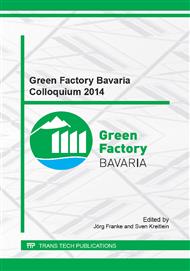p.41
p.47
p.53
p.61
p.69
p.75
p.83
p.89
p.95
Methodology to Increase Energy Efficiency in Discrete Manufacturing
Abstract:
The utilisation phase of machinery in discrete manufacturing operations is characterized by changing economical and technical requirements like capacity, performance and as emerging requirement reduced energy consumption. Established industry practices as well as upcoming standards mainly focus on improving the energy efficiency by developing new machinery. Especially existing factories and the machinery in use offers energy saving potentials to be identified and to be capitalized by implementing energy saving retrofit measures. By doing so, the use of existing manufacturing machinery leads to a sustainable use of manufacturing equipment. The discussed research work therefore includes an approach to interpret in-process measurement data and to derive electric energy savings potentials. Based on this assessment, improvement measures like dimensioning, reduction of baseline energy-consumption by updating the PLC and minimisation of peak loads by energy management is engineered. Finally the financial impact of the obtained energy savings is quantified by evaluating the developed methodology during several use cases.
Info:
Periodical:
Pages:
69-74
Citation:
Online since:
October 2014
Authors:
Price:
Сopyright:
© 2014 Trans Tech Publications Ltd. All Rights Reserved
Share:
Citation:


